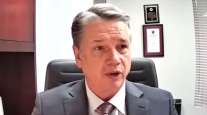Senior Reporter
‘Mongoose Method’ Helps Carriers Fight ‘Reptile Theory’ Attorney Tactics

[Stay on top of transportation news: Get TTNews in your inbox.]
For more than a decade, plaintiff attorneys have been beating up on truckers in accident litigation using a courtroom strategy known as the “reptile theory,” which aims to manipulate jurors’ fears and emotional responses to elicit multimillion-dollar “nuclear” jury verdicts.
Now, a counter strategy that is gaining attention among motor carriers — known as the “mongoose method” — aims to counter these attacks and crush the reptile.
“The plaintiffs’ bar has been kicking our teeth, preparing and widely educating each other on how to attack us,” said John Esparza, president of the Texas Trucking Association. “And we’ve not done anything about it.”

Esparza
That began to change about a year ago, when Nevada Trucking Association President Paul Enos attended a seminar in Washington, D.C., led by Dallas attorney Michael Bassett and Bill Kanasky, an expert in the areas of advanced witness training and jury psychology and vice president of Courtroom Sciences Inc.
The mongoose method attempts to educate corporate executives — and sometimes drivers — who are called to testify in pretrial depositions where plaintiff attorneys, through skillful tactics, steer the narrative into subjects other than those directly related to the accident.
Enos coined the term “mongoose method,” borrowing the name from the animal kingdom. In nature, the reptile cobra snake is an awesome contender that few competitors dare challenge. Only one, the mongoose, has the quickness and ferocity to take on the fearsome reptile.
“The trial lawyers absolutely exploit the reptile theory,” Enos said. “Plaintiff attorneys are extremely good at what they do. We need to be as good as they are. We need to get to a point where we know what their tricks are, we know what their traps are, and we’re able to properly defend and represent ourselves.”

Enos
Enos decided that since his state’s leaders weren’t immediately advancing the lawsuit abuse legislation his association was advocating, he would instead educate his members on legal defense strategies via the mongoose method. Enos said he worked with Kanasky in developing slides and a website explaining the mongoose method, and Kanasky led many seminars hosted by the association on the method.
Curiosity about the mongoose method has since grown, and a number of trucking associations have either held or scheduled workshops on the method.
“We can make our folks better in the courtroom,” Enos said. “You’re not going to win a case through depositions, but you sure can lose one, depending on what you say and how you react.”
The most troublesome deposition is called the 30(b)(6) deposition, so named after its designation in federal and state civil rules of procedure. A plaintiff attorney can essentially broach any area of questioning, said Mike Mills, an attorney with Las Vegas-based Bauman Loewe Witt & Maxwell, who has worked with Enos. Answers given by trucking executives during depositions can be used against them at trial, he said.
“The mongoose method is simply training that is going to inform trucking companies and truck drivers what to expect when the plaintiff attorneys start to ask questions that trend toward this reptile theory,” Mills said. “The idea is plaintiff attorneys are going to try to create a standard that nobody can meet. It doesn’t matter how many training sessions you’ve had or how well you have hired your drivers. They’re going to suggest that somehow — because you are operating on the road and you maybe fail to do one thing — that you are automatically responsible for whatever might befall their clients.”
Esparza added, “I think it’s key to motor carrier health moving forward. Texas has had a pretty nasty environment for these frivolous lawsuits. The mongoose method is going to be around for a while.”
He noted that his association is joining Nevada’s on some future mongoose method sessions.
“The litigation psychology is the biggest element of the mongoose method,” Esparza said. “It is really the courtroom science behind what tactics are being utilized against motor carriers, so that you’re understanding where this plaintiff attorney is trying to take you.”
He added, “I hope you never do find yourself in that courtroom with a billboard lawyer. But if you do, here’s how they’re going to exploit the jury against you. That’s important to know on the front end.”
During deposition and trial, plaintiff attorneys typically ask general questions such as, “I noticed your company says safety is your No. 1 priority. Would you agree?” If a company executive answers in the affirmative, the trap is set. He or she has now been painted into a corner where every question must elicit a “yes” response, experts said.
“The appropriate answer might be, ‘Safety is one of the many things that are important to our business,’ ” said Gary Langston, president of the Indiana Motor Truck Association. Langston warns motor carriers not to use such claims as “safety is our top priority.”

Langston
Langston added, “It’s all about training the brain to avoid all the things that a human being naturally does when challenged or attacked, quite frankly. Reptiles go into attack mode when threatened or frightened. The unfortunate thing about the way plaintiff attorneys operate is that the last thing they really ever want to talk about are the facts of the case.”
Langston added, “The biggest factor in witness performance is cognitive fatigue. Most people don’t even like to speak in public much less be in a courtroom or be deposed by attorneys. The kind of stress, attention and fatigue that is created in that scenario is beyond what a person can tolerate.”
Some of the digging by plaintiff attorneys can involve how drivers are hired, trained and monitored, and what safety technologies a company may have adopted.

Amar
For example, Esparza recounted a call he recently received from a member who said during an eight-hour deposition for an ongoing case the facts of the accident were not discussed once. “I think the mongoose method is spot on,” said Renee Amar, executive director of the Louisiana Motor Transport Association. “I think it’s brilliant what they’re doing in Nevada.”
Amar said members from her association praised a mongoose method workshop it hosted a few months ago.
“They said as long as LMTA has been in existence, this was the most educational piece of material to help them in their businesses that they’ve ever gotten,” Amar said. “That was very profound.”
The LMTA Foundation’s website describes the mongoose method in the following manner: “The mongoose method is conceived to restore balance to our justice system. The goal is to beef up the arsenal of our defense bar; train our members to proactively recognize and avoid traps; educate employees and the greater business community that depend so heavily on our services. Among other things, mongoose method will sharpen awareness to reptile theory tactics in depositions and trials. It will make us less vulnerable during litigation and allow us to go on the offensive.”
“The method works because we’re letting people know what the traps are that the trial bar is setting them up,” Enos said. “Knowing the script that your adversary wants you to follow, and not going down that path, I really think that’s the key.”
Want more news? Listen to today's daily briefing below or go here for more info:




